Solar eclipse of March 30, 2052
A total solar eclipse will occur at the Moon’s descending node of the orbit on Saturday, March 30, 2052. A solar eclipse occurs when the Moon passes between Earth and the Sun, thereby totally or partly obscuring the image of the Sun for a viewer on Earth. A total solar eclipse occurs when the Moon's apparent diameter is larger than the Sun's, blocking all direct sunlight, turning day into darkness. Totality occurs in a narrow path across Earth's surface, with the partial solar eclipse visible over a surrounding region thousands of kilometres wide. The path of totality will cross central Mexico and the southeastern states of the United States. Almost all of North America and the northern edge of South America will see a partial eclipse. It will be the 2nd total eclipse visible from the Florida Panhandle and southwest Georgia in 6.6 years. It will be the first total solar eclipse visible from Solar Saros 130 in 223 synodic months.
| Solar eclipse of March 30, 2052 | |
|---|---|
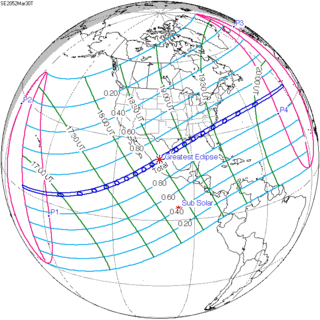 Map | |
| Type of eclipse | |
| Nature | Total |
| Gamma | 0.3238 |
| Magnitude | 1.0466 |
| Maximum eclipse | |
| Duration | 248 sec (4 m 8 s) |
| Coordinates | 22.4°N 102.5°W |
| Max. width of band | 164 km (102 mi) |
| Times (UTC) | |
| Greatest eclipse | 18:31:53 |
| References | |
| Saros | 130 (54 of 73) |
| Catalog # (SE5000) | 9623 |
Related eclipses
Solar eclipses 2051–2054
This eclipse is a member of a semester series. An eclipse in a semester series of solar eclipses repeats approximately every 177 days and 4 hours (a semester) at alternating nodes of the Moon's orbit.[1]
| Solar eclipse series sets from 2051–2054 | ||||
|---|---|---|---|---|
| Descending node | Ascending node | |||
| Saros | Map | Saros | Map | |
| 120 | April 11, 2051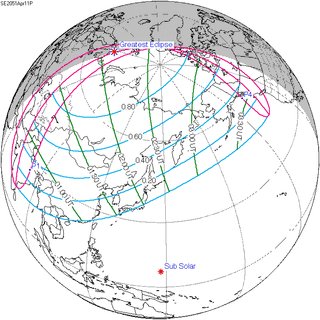 Partial |
125 | October 4, 2051 Partial | |
| 130 | March 30, 2052 Total |
135 | September 22, 2052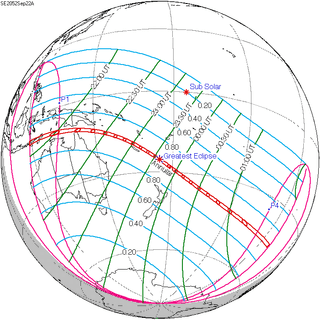 Annular | |
| 140 | March 20, 2053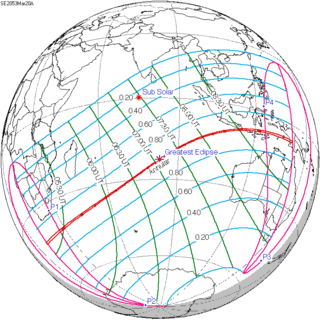 Annular |
145 | September 12, 2053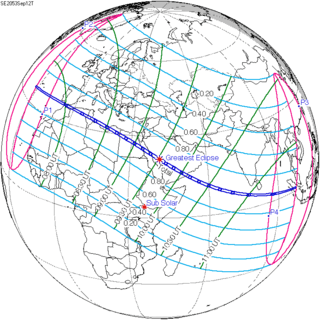 Total | |
| 150 | March 9, 2054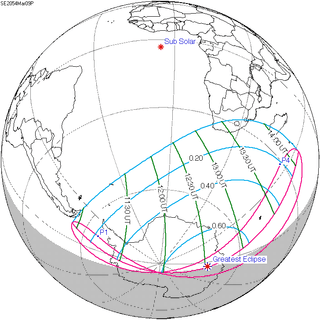 Partial |
155 | September 2, 2054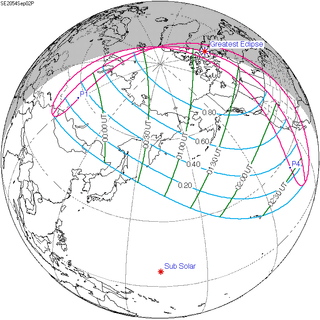 Partial | |
Saros 130
This eclipse is a part of Saros cycle 130, repeating every 18 years, 11 days, containing 73 events. The series started with partial solar eclipse on August 20, 1096. It contains total eclipses from April 5, 1475 through July 18, 2232. There are no annular eclipses in the series. The series ends at member 73 as a partial eclipse on October 25, 2394. The longest duration of totality was 6 minutes, 41 seconds on July 11, 1619. All eclipses in this series occurs at the Moon’s descending node.[2]
| Series members 43–56 between 1853 and 2300 | ||
|---|---|---|
| 43 | 44 | 45 |
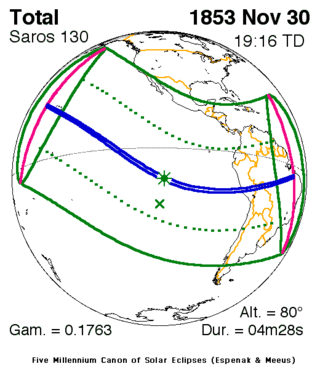 November 30, 1853 |
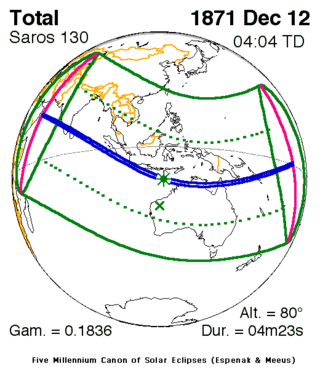 December 12, 1871 |
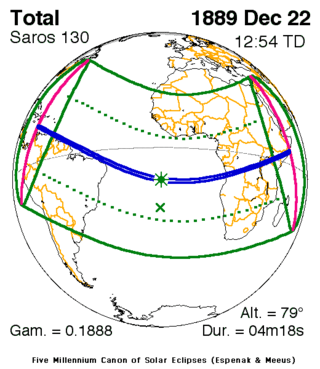 December 22, 1889 |
| 46 | 47 | 48 |
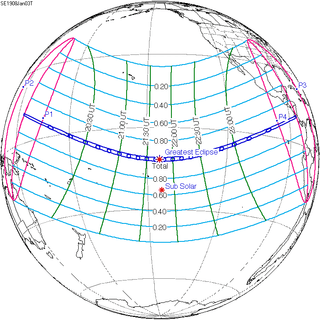 January 3, 1908 |
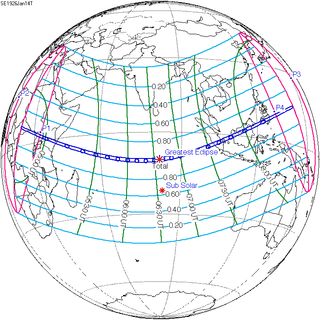 January 14, 1926 |
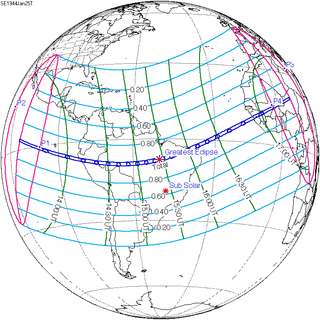 January 25, 1944 |
| 49 | 50 | 51 |
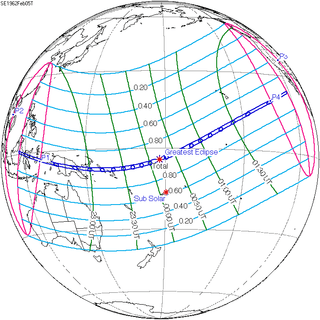 February 5, 1962 |
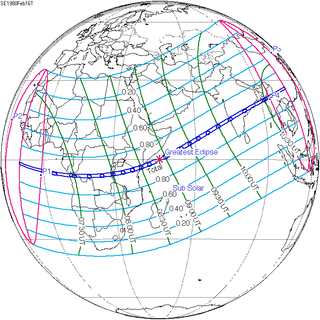 February 16, 1980 |
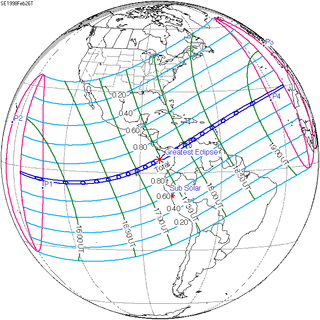 February 26, 1998 |
| 52 | 53 | 54 |
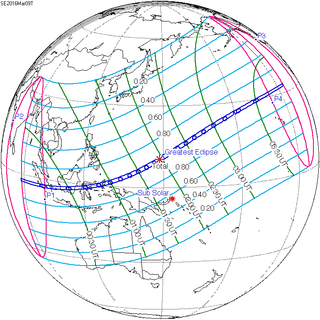 March 9, 2016 |
 March 20, 2034 |
 March 30, 2052 |
| 55 | 56 | 57 |
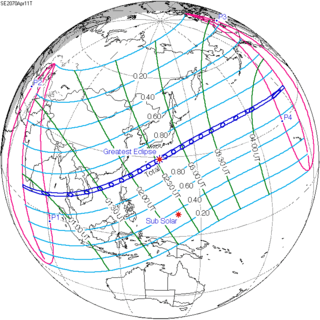 April 11, 2070 |
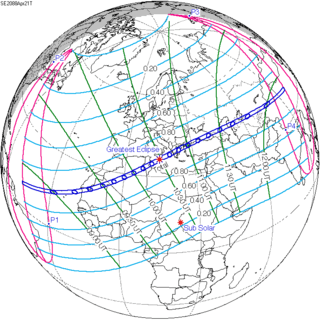 April 21, 2088 |
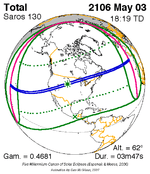 May 3, 2106 |
| 58 | 59 | 60 |
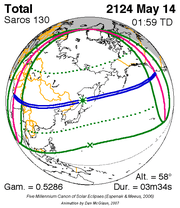 May 14, 2124 |
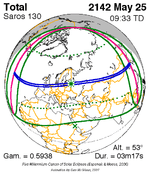 May 25, 2142 |
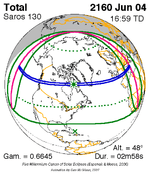 June 4, 2160 |
| 61 | 62 | 63 |
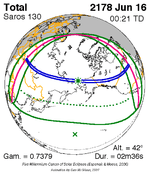 June 16, 2178 |
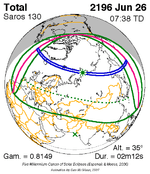 June 26, 2196 |
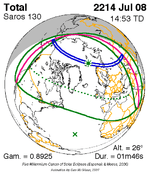 July 8, 2214 |
| 64 | 65 | 66 |
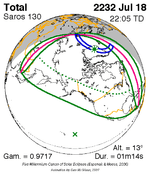 July 18, 2232 |
 July 30, 2250 |
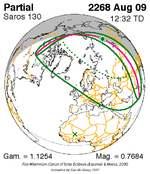 August 9, 2268 |
| 67 | ||
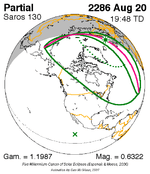 August 20, 2286 | ||
Inex series
This eclipse is a part of the long period inex cycle, repeating at alternating nodes, every 358 synodic months (≈ 10,571.95 days, or 29 years minus 20 days). Their appearance and longitude are irregular due to a lack of synchronization with the anomalistic month (period of perigee). However, groupings of 3 inex cycles (≈ 87 years minus 2 months) comes close (≈ 1,151.02 anomalistic months), so eclipses are similar in these groupings.
| Inex series members between 1901 and 2100: | ||
|---|---|---|
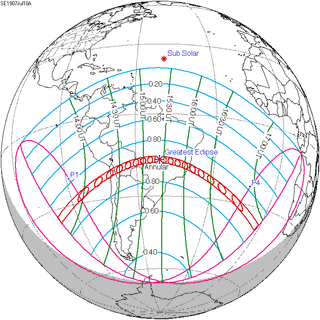 July 10, 1907 (Saros 125) |
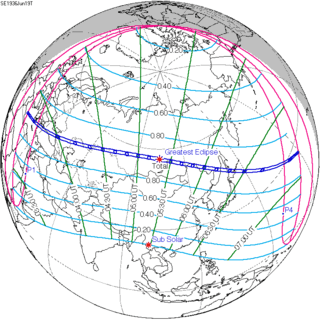 June 19, 1936 (Saros 126) |
 May 30, 1965 (Saros 127) |
 May 10, 1994 (Saros 128) |
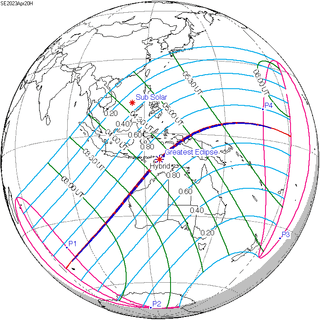 April 20, 2023 (Saros 129) |
 March 30, 2052 (Saros 130) |
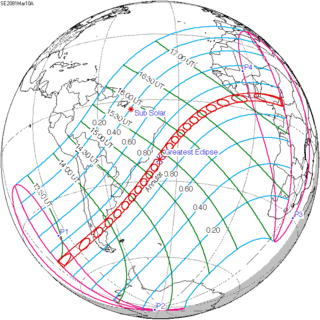 March 10, 2081 (Saros 131) |
||
Metonic cycle
The metonic series repeats eclipses every 19 years (6939.69 days), lasting about 5 cycles. Eclipses occur in nearly the same calendar date. In addition, the octon subseries repeats 1/5 of that or every 3.8 years (1387.94 days).
| 21 eclipse events between June 12, 2029 and June 12, 2105 | ||||
|---|---|---|---|---|
| June 11–12 | March 30–31 | January 16 | November 4–5 | August 23–24 |
| 118 | 120 | 122 | 124 | 126 |
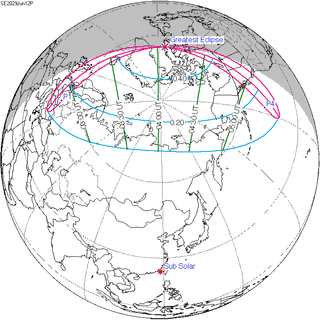 June 12, 2029 |
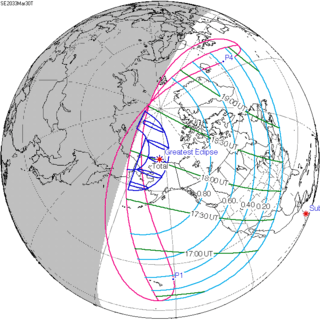 March 30, 2033 |
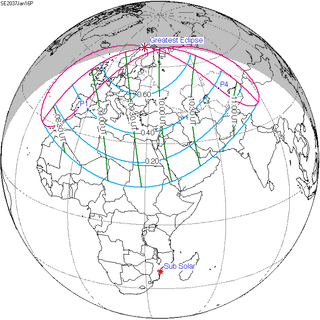 January 16, 2037 |
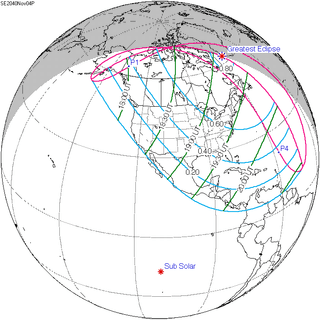 November 4, 2040 |
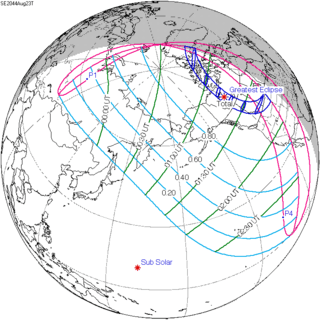 August 23, 2044 |
| 128 | 130 | 132 | 134 | 136 |
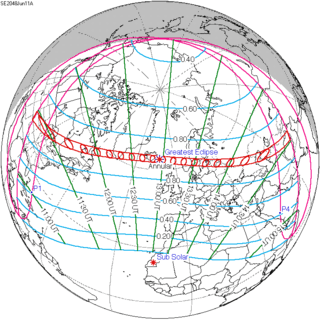 June 11, 2048 |
 March 30, 2052 |
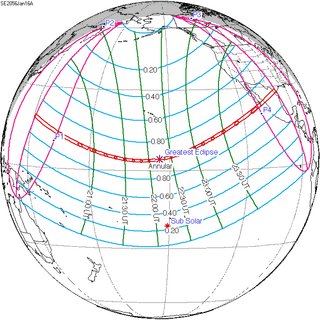 January 16, 2056 |
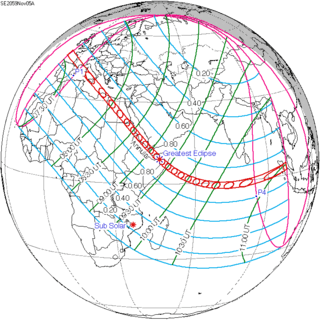 November 5, 2059 |
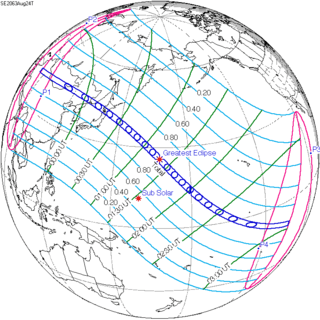 August 24, 2063 |
| 138 | 140 | 142 | 144 | 146 |
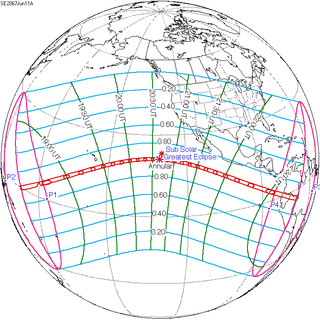 June 11, 2067 |
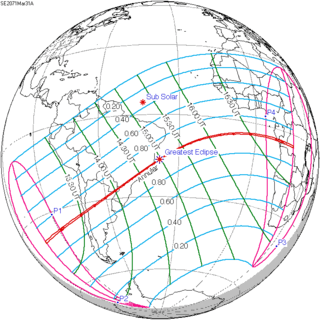 March 31, 2071 |
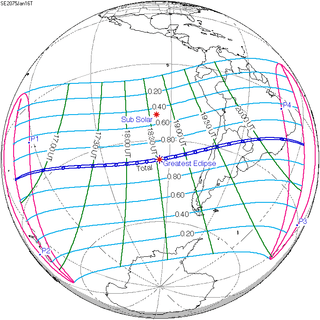 January 16, 2075 |
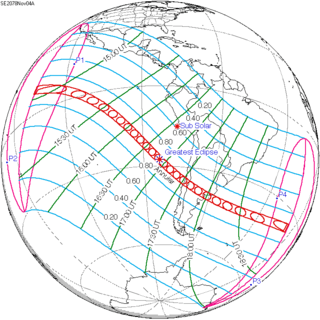 November 4, 2078 |
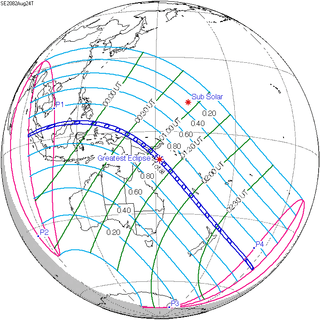 August 24, 2082 |
| 148 | 150 | 152 | 154 | |
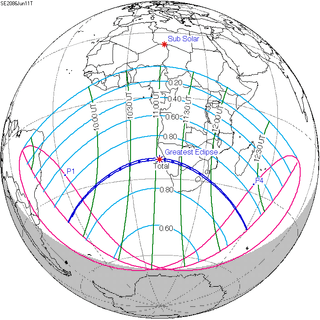 June 11, 2086 |
 March 31, 2090 |
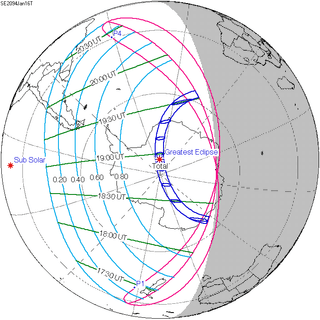 January 16, 2094 |
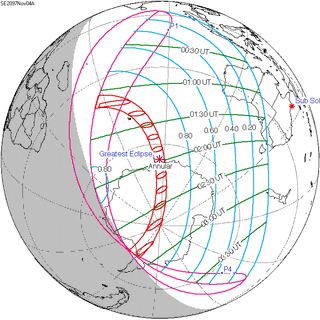 November 4, 2097 | |
Notes
- van Gent, R.H. "Solar- and Lunar-Eclipse Predictions from Antiquity to the Present". A Catalogue of Eclipse Cycles. Utrecht University. Retrieved 6 October 2018.
- "Saros Series catalog of solar eclipses". NASA.
References
- Earth visibility chart and eclipse statistics Eclipse Predictions by Fred Espenak, NASA/GSFC
.jpg)
